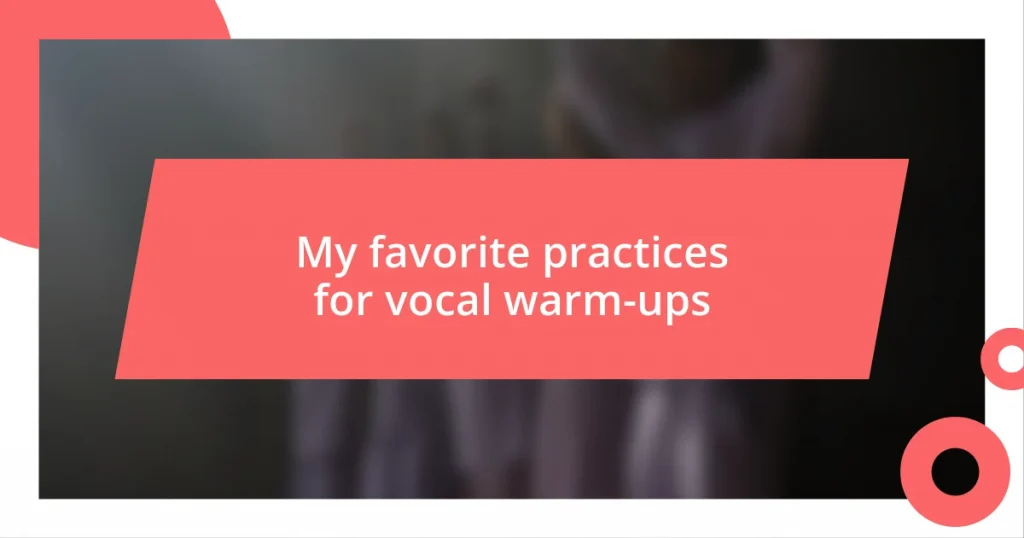Key takeaways:
- Vocal warm-ups are essential for maintaining vocal health, enhancing flexibility, and providing mental preparation for performances.
- Effective warm-up techniques include humming, lip trills, vocal slides, and breathing exercises, each serving a specific purpose for vocal development.
- Consistent practice, tracking progress, and setting a warm-up schedule can greatly improve vocal performance and help manage anxiety.

Importance of Vocal Warm-ups
Vocal warm-ups are essential for maintaining vocal health and preventing strain. I remember a time when I skipped my warm-ups before a big performance. The result? I struggled to hit the high notes, leaving me frustrated and embarrassed. Have you ever felt that twinge of panic when your voice just won’t cooperate? That’s why warm-ups aren’t just a routine; they are a lifeline for any singer.
Beyond just preserving your voice, warm-ups enhance vocal flexibility and control. Think of it as a workout for your vocal cords. By regularly practicing warm-ups, you can discover new ranges you might not have thought possible. I vividly recall the thrill of hitting a note I once found too challenging, all because I made warm-ups a priority. Isn’t it fascinating to think how dedicated practice can open new doors?
Additionally, warm-ups serve as a mental preparation tool. They help me focus my mind, easing performance anxiety before stepping on stage. Have you ever felt your nerves start to creep in? Engaging in warm-ups channels that energy positively, transforming anxiety into excitement. It’s an exhilarating way to connect with my voice and prepare myself for the emotional journey of performing.

Basic Warm-up Techniques
Vocal warm-ups can encompass a variety of techniques, each serving a unique purpose. I often start with humming, as it gently engages the vocal cords without straining them. Remember the last time you hummed your favorite tune? It’s soothing and helps me find my pitch while warming up my voice.
Next, I integrate lip trills into my warm-up routine. The sensation of buzzing my lips together while sliding through notes is incredibly refreshing. Lip trills are fantastic for enhancing breath control and easing tension. I recall a rehearsal where utilizing lip trills transformed my vocal performance, allowing for smoother transitions between notes.
Finally, vocal slides or sirens are an invaluable technique for expanding vocal range. Sliding from low to high notes feels almost like a siren’s call, and I love how it helps loosen my vocal cords. Incorporating this technique not only feels liberating but also progressively stretches my voice to reach those challenging higher pitches.
| Technique | Benefits |
|---|---|
| Humming | Gentle engagement of vocal cords, pitch finding |
| Lip Trills | Improves breath control, eases tension |
| Vocal Slides | Expands vocal range, warms up vocal cords |
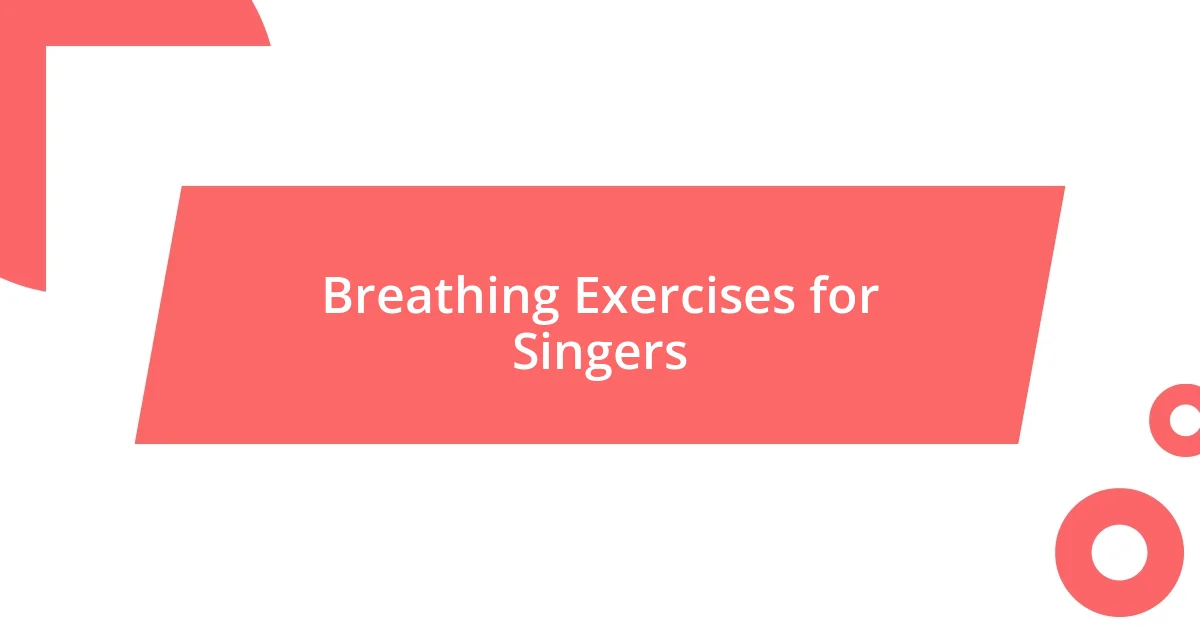
Breathing Exercises for Singers
Breath is the foundation of singing, and mastering breathing techniques can significantly elevate your performance. One day, I was rehearsing a particularly demanding piece when I noticed I was running out of breath mid-phrase. It hit me that I needed to hone my breath control. Since then, I’ve added focused breathing exercises to my routine, and the improvement in my vocal stamina is undeniable.
Here are some effective breathing exercises that I find helpful:
- Diaphragmatic Breathing: Place a hand on your stomach and inhale deeply. Feel your stomach expand rather than your chest. This technique ensures you are using your diaphragm effectively.
- Sustained Hisses: Take a deep breath and exhale slowly while making a hissing sound. Try to make the sound last as long as possible. It’s a fun way to build breath control and awareness.
- Pursed-Lip Breathing: Inhale through your nose, then exhale slowly through pursed lips, like you’re blowing a gentle breeze. This exercise helps regulate airflow and can calm pre-performance nerves.
Incorporating these exercises into my warm-up routine has made a tremendous difference. I recall the first time I tried the sustained hisses; I was surprised at how long I could hold the sound. It was a thrilling realization that I could control my breath—making those long phrases feel much more manageable during performances. These exercises not only improve my singing but also deepen my connection to my breath, which is such a vital aspect of vocal expression.
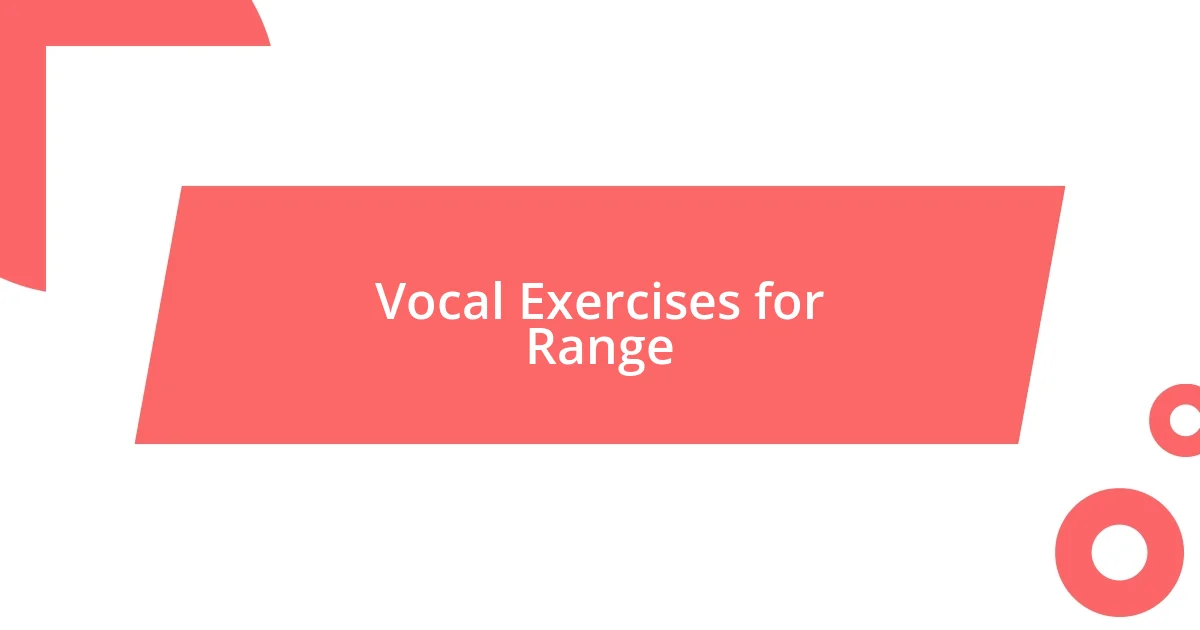
Vocal Exercises for Range
Vocal exercises specifically targeting range are essential for any singer looking to push their limits. I absolutely swear by octave jumps for this purpose—jumping up and down the scale not only stretches my vocal cords but also gives me that exhilarating feeling of soaring through my range. Have you ever felt that rush when you hit a note you thought you couldn’t reach? It’s an addictive thrill that keeps me motivated to improve.
Another effective exercise I’ve found is the “Ah” vowel variation, where I sing the “ah” sound across different pitches. Picture the sensation of your voice gliding smoothly from chest voice to head voice. The beauty of this technique lies in its ability to blend both registers seamlessly, creating a strong, unified sound. I remember one session where I did this and felt an unexpected resonance in my voice that left me energized and excited for what was next.
Lastly, I can’t emphasize enough the power of scales, especially major and minor scales. Singing these in various keys helps not only to familiarize myself with different notes but also to develop muscle memory. It’s like a workout for my voice! I recall practicing a challenging song and realizing that my scale work directly contributed to my ease in hitting those tricky notes in the chorus. It’s moments like these that affirm the importance of consistent range exercises—they truly pay off when it counts most.
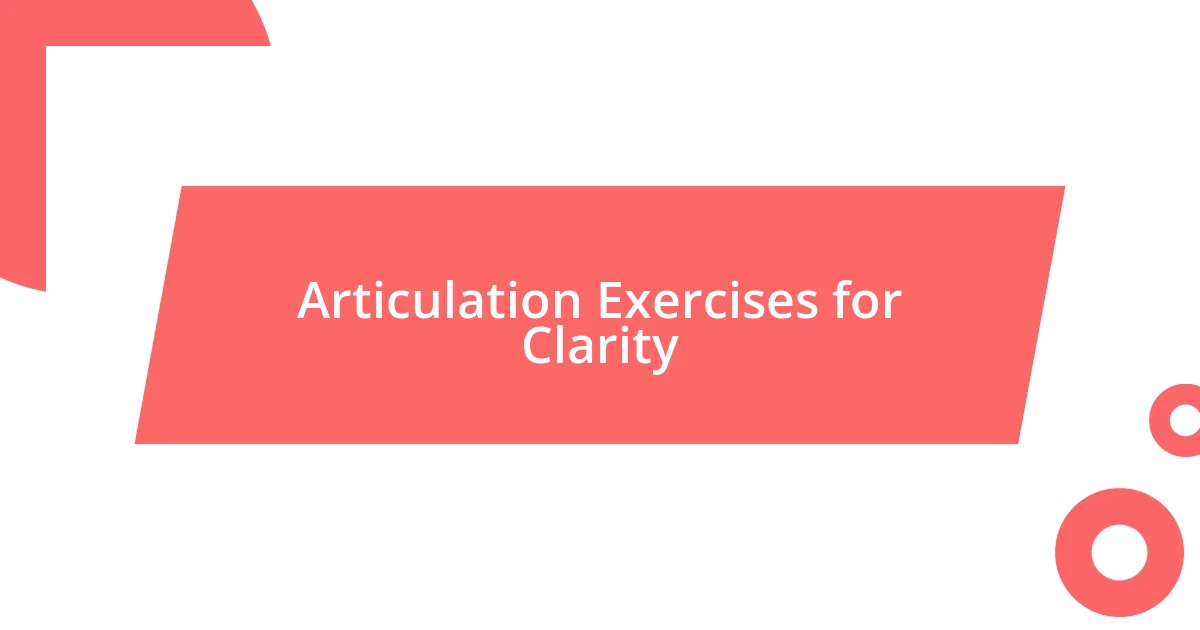
Articulation Exercises for Clarity
Articulation is vital for clear communication in singing, and I find that specific exercises can help refine this skill beautifully. One of my favorites is tongue twisters; they not only challenge my articulation but also add an element of fun to my warm-up. Just the other day, I was tackling “She sells seashells by the seashore,” and I noticed how my face lit up with each successful repetition. It’s a delightful reminder that clarity in speech leads to clarity in song.
Another exercise I swear by is the “Buzzy Bee” technique, where I hum with closed lips while feeling the vibrations. This practice really helps me engage my facial muscles, and I often feel a delightful tingle around my mouth and nose. Have you experienced that sensation? It’s not just amusing; it connects the sound with the physical articulation, enhancing clarity in my singing. I remember a performance where I had neglected this warm-up, and the difference was startling—my words felt muddled, and I could sense the audience straining to understand.
Lastly, “Five Chewy Taffies” is an absolute gem! I exaggerate the pronunciation of each word, over-enunciating as I sing through a series of pitches. It feels a bit silly at first, but I promise it’s effective! Once, I performed a piece where I hadn’t fully warmed up my articulation, and I could hear the slurring affect my confidence. It served as a lesson—taking the time for these articulation exercises prevents those mishaps and truly enhances my overall performance. Have you ever noticed how clarity in the lyrics can transform the emotional impact of a song?

Cool Down Practices for Voices
Cooling down my voice after a long session is as important as warming up. One of my favorite ways to do this is by gently humming in a descending scale. I find this practice both soothing and grounding. When I feel the vibrations resonate comfortably in my chest, it’s like a soft embrace for my vocal cords—an essential way to signal them to relax after exertion.
Another technique I often use involves sipping warm herbal tea while softly vocalizing a few sustained notes. I remember one performance night where I pushed my limits during rehearsal. Once it was over, I warmed up some tea, letting the steam rise while I sang lightly, and I felt my body and voice starting to unwind. It’s a simple act that goes a long way in helping me feel balanced and ready for what’s next.
Lastly, I absolutely love the “soft sigh” exercise. I take a deep breath and release it with a gentle “ha” sound, allowing my voice to fade like a whisper. There’s something incredibly cathartic about it. It not only calms my mind but also helps in letting go of any build-up tension. Have you ever tried this? Each sigh encourages me to connect deeper with my voice, making it an elegant way to conclude my singing sessions while ensuring I’m ready for tomorrow!
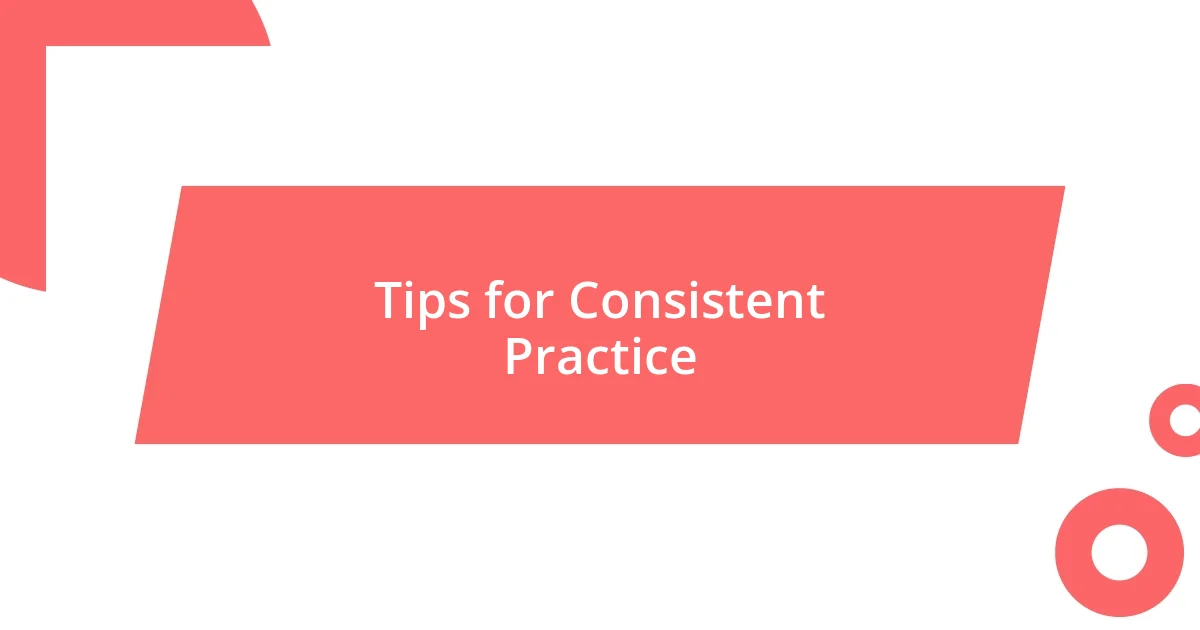
Tips for Consistent Practice
When it comes to practicing consistently, I’ve found that setting a specific time each day to warm up makes all the difference. I usually choose early mornings when my voice feels fresh. Have you ever noticed how sticking to a schedule can transform your routine? It’s like building a muscle; the more you flex it, the stronger it becomes.
On days when motivation wanes, I try to remind myself of the joy that singing brings me. For instance, I keep a playlist of songs that inspire me right next to my practice area. The other day, I replayed my favorite ballad before warming up, and it instantly reignited my passion. Those moments of inspiration are what fuel my commitment and remind me that every practice session enhances my artistry.
Finally, I believe it’s crucial to track my progress, and I do this with a simple journal. I jot down what exercises I enjoyed, any breakthroughs I experienced, and even moments that challenged me. Just last week, I noted how a certain warm-up made my high notes feel more accessible. Isn’t it satisfying to see how far you’ve come? This practice not only keeps me accountable but also helps me celebrate the small victories along the way!










